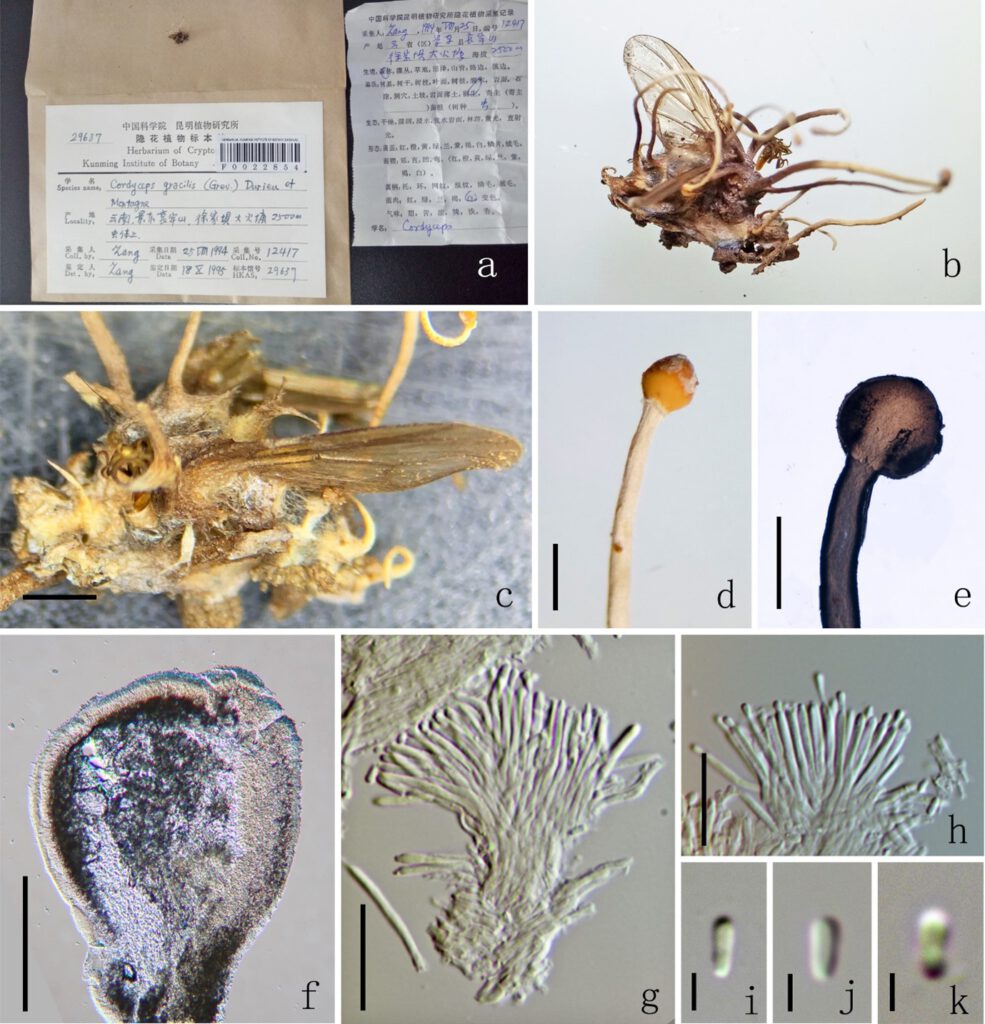Polycephalomyces ditmarii Van Vooren & Audibert, Bull. mens. Soc. linn. Lyon 74(7-8): 231 (2005) Fig. 8
MycoBank number: MB 511222; Index Fungorum number: IF 511222; Facesoffungi number: FoF 10733;
Parasitism on Paravespula sp. (Orthoptera, Gryllotalpidae) (See Fig. 10). Sexual morph: Undetermined. Asexual morph: Hyphomycetes. Synnemata 0.5–2 cm long, 0.5–1 mm wide, arising from the whole body of wasp, stipitate, scattered, unbranched, white to yellowish, several, cylindrical with an enlarged globose fertile head on the top. Fertile head 0.8–1 mm wide, globose, yellowish, coved with masses conidia. Stipe 1–1.9 mm long, 0.5–0.6 mm wide, cylindrical, white to pale yellow. Conidiophore 28–40 µm long ( = 34 µm, n = 60), concentrated in the fertile head, 1–3 phialides in one. Phialides 14–26 × 0.8–1.5 µm ( = 20 × 1.2 µm, n = 60), elongate oblong with a short tapering apex or narrowly cylindrical, one-type, hyaline, smooth, forming a hymenial layer covered the synnema. Conidia 2.7–3.8 × 0.9–1.2 µm ( = 3.2 × 1.1 µm, n = 60), 1-celled, one-type, hyaline, subglobose to pyriform.
Material examined: China, Yunnan Province, Jingdong County, Ailao mountain. Parasitic Paravespula sp. on the twig, 25 August 1994, Zang, HKAS29637.
Notes: Polycephalomyces ditmarii was described as pathogen on Paravespula vulgaris (wasp) from France (Van Vooren et al. 2005). The new collection is similar to Polycephalomyces ditmarii in that it is parasitic on wasp and produces stiptate synnemata, yellowish fertile head, elongate phialides, subglobose conidia (Table 7, Fig. 8). Thus, the new collection is identified as Polycephalomyces ditmarii, and it is a new record collected from China. The molecular data is still lacking for this species.

Fig. 8. Polycephalomyces ditmarii (New record –: HKAS29637) a Herbarium specimen. b Overview of Polycephalomyces ditmarii. c Host. d, e Synnema under microscope. f Vertical section of Synnema g, h Conidiophore with philidies. i–k Conidia. Scale Bars: c = 2 mm, d, e = 1000 µm, f = 500 µm, g, h = 10 µm, i–k = 2 µm.
